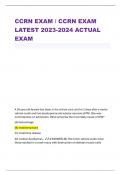CCRN EXAM / CCRN EXAM
LATEST 2023-2024 ACTUAL
EXAM
A 29 year old female has been in the critical care unit for 2 days after a motor
vehicle crash and has developed acute tubular necrosis (ATN). She was
normotensive on admission. What would be the most likely cause of ATN?
(A) hemorrhage
(B) rhabdomyolysis
(C) creatinine release
(D) cardiac dysthymias - ✔✔✔ANSWER-(B) The motor vehicle crash most
likely resulted in a crash injury with destruction of skeletal muscle cells
,(rhabdomyolysis). This results in the release of massive amounts of creatinine
kinase (CK) that, in turn, may CLOG renal tubules and lead to acute tubular
necrosis (ATN). Choice (A) is not correct as there is no history of bleeding.
Choice (C), creatinine release, is too vague, could be minor, and does not
cause ATN. Arrhythmias, choice (D), are not included in the scenario.
A 52 year old male presents with complaints of blurred vision and shortness
of breath. B/P is 232/136, heart rate 102, respiratory rate 28 with crackles in
lower lung fields bilaterally, with S3 and S4 heart sounds on auscultation.
Which of the following would be indicated for this patient?
(A) nitroprusside drip, admit to critical care unit
(B) digoxin, furosemide
(C) labetalol drip, admit to a medical unit
(D) lisinopril, calcium channel blocker - ✔✔✔ANSWER-(A) The patient has
signs of organ dysfunction (heart failure) secondary to extreme hypertension.
Therefore, he has hypertension crisis or emergency. The B/P needs to be
emergently decreased. Most often this treatment is best done in an ICU.
A 58 year old patient developed chest pain that he scored as an "8" Rapid
assessment included profuse diaphoresis, B/P 78/52, heart rate 104/minute,
respiratory rate 20/minute, lungs clear, and SpO2 98%. The patient is currently
connected to the bedside monitor with a nasal cannula at 2 L/min in place
and intravenous fluids, 0.9 NS at a rate of 10 ml/hour. Which of the following
sequences of interventions would be the most appropriate for the nurse at
this time?
(A) give a chewable aspirin, do an EKG, and start a fluid bolus
(B) give NTG sublingual, increase the FiO2 and give morphine
(C) do an EKG, give NTG sublingual, and give a chewable aspirin
, (D) start a fluid bolus, give a chewable aspirin, and do an EKG -
✔✔✔ANSWER-(D) The clinical description may be that of acute coronary
syndrome complicated by hypotension. Addressing the hypotension is a
priority as this is further decreasing coronary artery perfusion. A fluid bolus
would address hypotension, and no contraindications seem to be present for
a fluid bolus as lungs are clear. Aspirin is indicated for acutely chest pain and
could be given while preparing to do the EKG, which is needed to help make
the diagnosis.
A 59 year old male is admitted complaining of chest pain and dyspnea. ST
elevation and T wave inversion were seen on the EKG in V2,V3 and V4. IV
thrombolytic therapy was started in ED. Indications of successful reperfusion
would include all of the following except:
(A) pain cessation
(B) decrease in CK or troponin
(C) reversal of ST segment elevation with return to baseline
(D) short runs of ventricular tachycardia - ✔✔✔ANSWER-(B)Coronary artery
reperfusion due to PCI or fibrinolysis results in an ELEVATION of creatinine
kinase (CK) or troponin, not decrease. The theory is that the return of blood
flow distal to the occlusion can result in 'reperfusion injury' of the muscle,
elevating cardiac biomarkers.
The other 3 choices are indicators of reperfusion: Pain cessation, reversal of
ST segment elevation with return to baseline, short runs of ventricular
tachycardia.
A patient complains of sudden dyspnea 5 days S/P acute MI (ST elevation in II,
III, and aVF, with ST depression in I and aVL). The patient is anxious,
diaphoretic, and hypotensive. Examination reveals the development of a loud
holosystolic murmur at the apex. What is the most likely cause of this
patient's deterioration?




